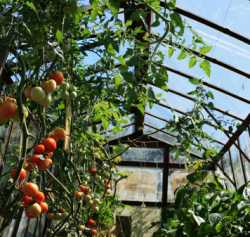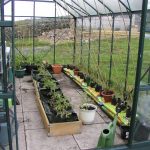Growing tomatoes in a greenhouse is far more certain to produce a good crop than outdoors as you control the climate. In fact, I would not even try to grow outdoors in the ground north of the Midlands in the UK without some extra shelter.
 Growing tomatoes in a greenhouse is a large subject which I have broken down into a number of separate, in-depth articles which are linked to from this article.
Growing tomatoes in a greenhouse is a large subject which I have broken down into a number of separate, in-depth articles which are linked to from this article.
The first thing is to decide which varieties of the hundreds available to grow. This is covered in:
Best Tomatoes for Greenhouse Growing
Having decided which tomatoes to grow, this article covers sowing and growing on to the point where you are ready to plant out:
Sowing & Starting off Tomatoes
Where to plant in the greenhouse
You have basically three choices. You can grow in a border, pots or grow bags and I’ll cover the methods for each separately.
Growing Tomatoes in the Greenhouse Border
Growing Tomatoes in Pots or Grow Bags in the Greenhouse
Supporting Cordon Tomatoes in the Greenhouse
As your tomatoes grow, they’ll require supporting. There are two main methods – string supports or canes.
Stringing Tomatoes – How to String Support Tomatoes
Commercially and traditionally cordon tomatoes have been supported on string. This is anchored at the base of the plant and taken to a point usually on the greenhouse roof.
Once the plant has reach about 18” (45cm) high it is likely to flop over and it is time to string it.
The string is tied to a convenient cross-bar or point on the frame above the plant. It is taken down to the plant and tied to the plant by creating a loose noose at the base. Then it is wrapped around the plant a couple of times
As the plant grows the twine is twisted around the plant supporting it. It is very easy to do and quick to continue as the plant grows. Initially do not put too much strain on the plant or you can pull it out of the pot or border.
Pole or Cane Supporting Tomatoes
The other method for supporting cordon tomatoes is to insert a bamboo cane by the plant and tie the stem to the cane as it grows. I use a figure of eight with the string so the plant stem has room to expand as it grows.
Commercial growers grow cordons at an angle rather than vertical. Those guys know what they’re doing and if you have the room it may increase yield – although home growers are looking at just 5 to 7 trusses not the 25 + trusses of the commercial grower’s tomato plants.
Ideal Temperature for Growing Greenhouse Tomatoes
The ideal temperature would be between 20ºC and 24ºC in the day, allowing it to drop to no lower than 18ºC at night. You can get away with lower temperatures but most harm is done by home growers allowing their greenhouse to overheat in the summer.
The use of shading to prevent over-heating is a good idea most summers, even in Britain. There’s a more detailed article here:
Ideal Temperature for Growing Greenhouse Tomatoes
Watering Greenhouse Tomatoes
I touch on watering for both border-grown and container-grown tomatoes in the specific articles on those mentioned above.
There is an article specifically on water requirements of tomatoes here:
And an article on equipment to help with greenhouse watering here:
Water Requirements for Tomatoes
Cultivation of Greenhouse Tomatoes
Feeding Greenhouse Tomatoes
The feeding regime for tomatoes is quite straightforward. When the first truss has set, which means the flowers have gone and you can see tomatoes beginning to form, it’s time to start feeding. Begin feeding either with a commercial feed as per the instructions or home-made feed such as comfrey liquid on a weekly basis.
I would always use a good quality commercial feed with trace elements to prevent magnesium deficiency rather than cheap commercial feeds. Towards the end of the season, I replace one feed in three with a high-nitrogen general feed such as Miracle Gro. It seems to help the plant maintain its general health and extend productivity.
Side-shoot (Sucker) Removal from Cordon Tomatoes
Apart from feeding and watering, with cordon tomatoes in the greenhouse you will need to remove side-shoots to encourage fruit production and stop the growth towards the end of the season.
Removing Tomato Side Shoots (Suckers) & Stopping Tomatoes
End of Season
At the end of the season before the first frost, harvest all the green tomatoes of reasonable size and these can either be ripened or used in chutney etc.
You can also hang up the vines with fruit on in a frost-free, cool dark place and they will slowly ripen. If kept in a bowl with a ripe banana they will ripen quickly due to the gas given off by the banana
Further Information: Tomato Growing Guides
- Grow Unusual Tomatoes!
- Types of Tomatoes – An Introduction to Tomato Growing Part 1
- Sowing and Starting off Tomatoes – Introduction to Tomato Growing Part 2
- Growing Tomatoes in a Tomato Grow-house (Mini-Greenhouse)
- Growing Tomatoes in a Greenhouse
- Growing Tomatoes in the Greenhouse Border
- Growing Tomatoes in Pots or Grow Bags in the Greenhouse
- Growing Tomatoes by Ring Culture
- Growing Tomatoes in Straw Bales
- Growing Tomatoes Outdoors
- Planting & Growing Tomatoes Outdoors
- Growing Patio Tomatoes – Dwarf Bush Variety Patio Tomatoes
- Water Requirements for Tomatoes
- Ideal Temperatures for Growing Tomatoes
- Removing Tomato Side Shoots (Suckers) & Stopping Tomatoes
- Best Tomato Varieties – My Top Tasty Tomato Picks
- Heirloom Tomatoes (Heritage Tomatoes)
- Best Tomatoes for Greenhouse Growing
- Tomato Troubles & Diseases | Causes & Cures of Tomato Problems
- Raising Tomato Plants from Seed







